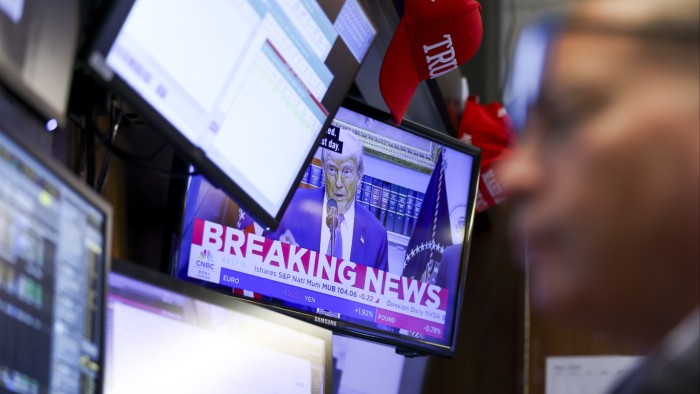Unlock the White House Watch newsletter for free
Your guide to what Trump’s second term means for Washington, business and the world
To prosper, businesses need to take calculated risks. Relocations, hiring decisions and product launches are based, in part, on boardrooms making calls on how economic trends will play out. Yet, in Donald Trump’s America, it is difficult to have any conviction on where the economy will be next month, let alone next year. References to “uncertainty” and “tariffs” have dominated US companies’ earnings calls this season. Executives cannot commit to decisions when the range of outcomes stemming from the US president’s global trade war remains so vast. Numerous businesses including Ford, American Airlines and Mattel have even decided to curb guidance on their sales and profits.
In the three months since Trump’s second-term inauguration, indices of US economic policy uncertainty — based on references in media articles — have shot up well beyond highs set during even the Covid-19 pandemic. The president embraces unpredictability. Last month, Treasury secretary Scott Bessent said that Trump created “strategic uncertainty” to gain leverage in trade negotiations. Stoking frenzied anticipation, more broadly, helps him garner attention. In the past, these tactics may have helped the real estate developer turned media personality to steamroller through deals or boost ratings. But when managing the world’s largest economy, they are deeply damaging.
Trump’s open-ended approach to tariff negotiations, in particular, has sapped American businesses. Year-ahead investment expectations have plunged. Import duties on countries and sectors that could fluctuate by tens of percentage points, in the space of a month or so, make it impossible for executives with global supply chains to plan ahead. Duties are essential components in calculating profit margins and are among the most complex elements of compliance for international organisations.
Trade agreements have a proven record of raising cross-border commerce and investment. But that is because they usually provide long-term confidence in stable and transparent trading terms. Trump is operating on months-long deadlines. Even if the president strikes further deals on his “reciprocal” tariffs, following recent settlements with the UK and China, faith that those duty rates will endure will be low. Trump is, after all, the self-anointed “tariff man”.
As long as that uncertainty lingers, the president’s ambition to impel foreign manufacturers, with the threat of duties, to invest in America will not be fully realised. The volatility will also stymie US companies. Producers with domestic supply chains tend to welcome Trump’s tariffs, as they help to block cheap imported competition. But these organisations cannot make decisions to expand either unless they know where trade policy — and hence their competitors — will end up. Indeed, as the FT reported, this week’s ceasefire in the US-China trade war is already driving early Christmas stockpiling as US retailers try to beat the potential expiry of the truce.
If businesses cannot plan, investors cannot accurately price equities or corporate bonds either. Policymakers are also perplexed. The US Federal Reserve’s April Beige Book mentioned the word “uncertainty” 80 times — more than during the Covid pandemic. In turn, financial stability risks from market volatility and mis-steps in monetary policy remain elevated.
The most rational response for organisations is to “wait and see”. The largest companies and those with the president’s ear may still thrive. But for most, trying to operate in real time, by updating decisions and exposures with each social media post, and every twist and turn in trade policy, is a fool’s game. Only when policy stability returns can the American economy bounce back to its dynamic best.


